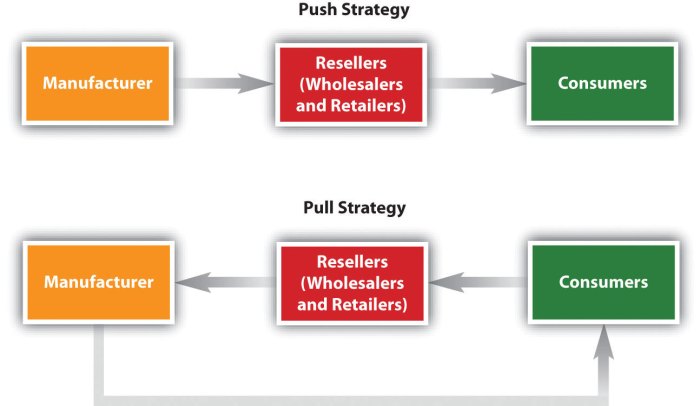When employing a push strategy a manufacturer – When employing a push strategy, a manufacturer takes the proactive approach of driving demand for its products through distribution channels, actively promoting them to distributors and retailers. This comprehensive strategy encompasses various aspects, from establishing effective distribution networks to utilizing marketing and sales techniques, all aimed at stimulating demand and increasing market share.
Manufacturers play a pivotal role in the success of a push strategy, assuming primary responsibility for generating interest and creating a desire for their products among distributors and retailers. They engage in a range of promotional activities, such as offering incentives, providing training, and organizing trade shows, to encourage these intermediaries to stock and promote their products.
When Employing a Push Strategy: Manufacturer’s Role and Strategies

A push strategy in marketing involves manufacturers actively promoting their products to distributors and retailers, who then push the products to consumers. This strategy differs from a pull strategy, where manufacturers rely on consumer demand to drive sales.
Manufacturer’s Role in Push Strategy
Manufacturers play a crucial role in implementing a successful push strategy. Their primary responsibilities include:
- Producing high-quality products that meet market demand.
- Setting competitive prices and offering incentives to distributors and retailers.
- Conducting marketing and promotional campaigns to raise awareness and generate demand.
li>Providing training and support to distributors and retailers to ensure effective product representation.
Examples of how manufacturers actively promote their products include offering discounts, rebates, and free samples to distributors and retailers. They may also participate in trade shows, conduct advertising campaigns, and provide marketing materials to support sales efforts.
Distribution Channel Management, When employing a push strategy a manufacturer
Establishing and managing effective distribution channels is critical for successful push strategies. Manufacturers must carefully select and collaborate with distributors and retailers who have strong market reach and credibility.
Strategies for selecting and collaborating with distributors and retailers include:
- Conducting thorough research to identify potential partners.
- Negotiating favorable terms and conditions.
- Providing ongoing support and training to ensure product knowledge and sales effectiveness.
Logistics and inventory management play a vital role in supporting push strategies. Manufacturers must ensure that products are available in sufficient quantities at the right time and place to meet demand.
Marketing and Promotion Tactics
Manufacturers employ various marketing and promotional tactics to drive demand for their products in push strategies. These tactics include:
- Advertising campaigns in print, broadcast, and digital media.
- Trade shows and industry events to showcase products and connect with potential customers.
- Sales promotions such as coupons, discounts, and loyalty programs.
In recent years, social media and influencer marketing have become increasingly important in push strategies. Manufacturers leverage these channels to reach consumers, build brand awareness, and generate leads.
Sales Force Management
Sales force plays a pivotal role in executing push strategies. Manufacturers must train, motivate, and manage their sales teams to effectively promote products to distributors and retailers.
Best practices for sales force management include:
- Providing comprehensive training on product knowledge and sales techniques.
- Setting clear sales targets and performance metrics.
- Offering incentives and recognition programs to motivate sales teams.
Manufacturers can use sales force automation tools to track sales performance, manage customer relationships, and provide real-time support to their sales teams.
Monitoring and Evaluation
Manufacturers must continuously monitor and evaluate the effectiveness of their push strategies. Key metrics include:
- Sales volume and market share.
- Distributor and retailer performance.
- Customer satisfaction and loyalty.
Manufacturers can use data analysis techniques to identify trends, measure ROI, and make adjustments to their push strategies based on performance data.
FAQ Guide: When Employing A Push Strategy A Manufacturer
What is the primary goal of a push strategy?
The primary goal of a push strategy is to stimulate demand for a product by actively promoting it through distribution channels, encouraging intermediaries to stock and promote the product to end consumers.
What are some key marketing tactics used in a push strategy?
Common marketing tactics employed in a push strategy include advertising campaigns, trade shows, sales promotions, social media marketing, and influencer marketing, all aimed at generating awareness and interest in the product.
How does sales force management contribute to a successful push strategy?
Sales force management plays a crucial role by training, motivating, and managing sales teams to effectively promote and sell the product to distributors and retailers, ensuring that the product reaches the intended market.

